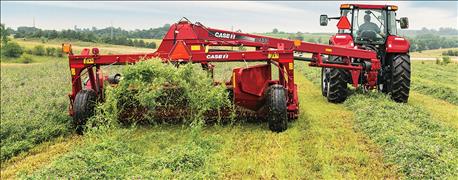June 29, 2016

The farmer had just purchased a new discbine. Yet, on the day Joe Lawrence, Cornell Pro-Dairy dairy forage systems specialist stopped in, the farmer and his equipment dealer were replacing the cutter bar shoes with thicker ones.
What goes? The dairyman had realized the new machine was cutting his grass forages much shorter than his former haybine, and he knew it wasn’t good for the grass.
Recommended cutting height isn’t a “one size fits all” scenario, stresses Lawrence. Whether new machines or older, they need to be set up appropriately for crop species, field conditions, ash content of the harvested forage, time of year and age of the stand.

NIPPING IT IN THE BUD? Cutting forage stands too low can put milk production at risk and slow grass recovery. Photo: Courtesy of CaseIH
Discbines tend to allow a closer cut without as much risk of damage like that incurred with traditional sicklebar mowers, he explains. That makes it very tempting to lower the cutting height a few inches to get extra yield. After all, Miner Institute research indicates you can gain up to a half-ton of dry matter in a three-cutting season by lower cutting height from 4 inches to 2 inches – without sacrificing quality.
So what’s the problem with scalping?
Actually there are three problems.
1. “Minimum-till haylage”, as Tom Kilcer, consultant for Advanced Ag Systems, calls it scalps uneven fields and increases forage ash content via dirt and debris. It’s a chronic forage ration problem on many dairies.
Dairy nutritionists, report that a 2% increase in ash, from 9% to 11%) can reduce milk by 1.9 pounds of milk per cow per day. That’s significant.
2. Cutting height makes it tougher for rakes, tedders and mergers to do their job. If set too close to the ground, they, too, can pump up forage ash content.
3. Regrowth can impacted, too. Since alfalfa generates new shoots from the plant crown, it can generally tolerate a very low cutting height. But a low grass-cutting height can be detrimental, since grasses have to re-grow from the stubble left in the field. Cut too short, the plants are robbed of the energy reserves needed for regrowth.
How’s that? Miner Institute greenhouse work found that first-year reed canarygrass was completely killed at a 2-inch cutting height. Orchardgrass clipped at that height did regrow, but at a much slower rate.
Two-inch orchardgrass required 38 days to reach 16 inches. But at the 4-inch cutting height, both grasses responded quickly after cutting and reached 16 inches of regrowth in just 21 days.
Cutting height considerations
Alfalfa: Manage cutting height based on field conditions, time of year and ash forage content. Also consider higher fall cutting height to help capture and retain snow cover.
Grass: A minimum of 3 to 4 inches of stubble is critical. Grass stands are even more sensitive in the seeding year. Loss of grass stand productivity from cutting too low far outweighs any yield boost of harvesting a few extra inches in a cutting.
Mixed stands: Cutting height could actually be used as a management tool for stand composition by choosing a cutting height that favors grass or alfalfa.
Source: Cornell Pro-Dairy
You May Also Like




